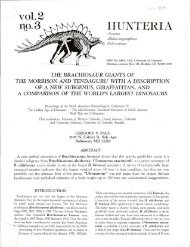THE MANY MYTHS, SOME OLD, SOME NEW, OF ... - Gregory S. Paul
THE MANY MYTHS, SOME OLD, SOME NEW, OF ... - Gregory S. Paul
THE MANY MYTHS, SOME OLD, SOME NEW, OF ... - Gregory S. Paul
Create successful ePaper yourself
Turn your PDF publications into a flip-book with our unique Google optimized e-Paper software.
92<br />
G. S. PAUL<br />
flies like a duck, and quacks like a duck, it's a duck! Placing lagosuchians in the<br />
Dinosauria tells us exactly what these little dinosaurs were.<br />
The common unification of prosauropods and sauropods in a single group is a more<br />
subtle denial of the group's biology, as well as a potentially unrealistic reflection of<br />
their relationships. The exact interrelationshps of basal herbivorous dinosaurs<br />
remains uncertain because of the lack of an adequate data base, and it is likely to<br />
remain so because of the limited number of characters that can be used to sort out<br />
relationships in the basal members of closely related groups, and the presence of<br />
extensive parallels and reversals in such taxa. It is therefore quite possible that<br />
prosauropods are directly ancestral to segnosaurs and/or ornithischians, and are a<br />
sister group to sauropods, or are ancestral to all three, or to none, and so on. In many<br />
cases the alliance of prosauropods and sauropods in the Sauropodomorpha would be<br />
incorrect. As it is, the Sauropodomorpha is more a reflection of the shared small<br />
headed, long necked nature of its members, than it is of their detailed relationships.<br />
It would promote stability to recognize the distinctive biology of the two groups. The<br />
sauropods are derived giants with short, rigid trunks and specialized, elephantine<br />
limbs, and are quite different from the flexible backed, primitive limbed prosauropods,<br />
which had partially developed cheek muscles. These differences should be<br />
formally recognized.<br />
REVERSALS CAN BE LARGELY NEGLECTED IN<br />
STUDIES <strong>OF</strong> DINOSAUR PHYLOGENETICS<br />
Myth: Advanced cladistic works on dinosaur phylogenetics need pay little attention<br />
to the possibility that reversals complicate understandings of their relationships.<br />
Reality: Reversals of morphology are probably very common in evolution, especially<br />
since this often does not require the development of new genetic instructions, but<br />
rather the release of a suppressed set of old instructions. An important example of<br />
this phenomenon may have occurred in the bird-like Cretaceous theropods. Features<br />
otherwise found in secondarily flightless birds suggest the theropods were secondarily<br />
flightless also, and that they experienced a set of reversals that returned them to a<br />
preflight status (<strong>Paul</strong>, 1988a). The forward direction of the pubes of some of these<br />
theropods may also represent a reversal from an archaeoptrygian-dromaeosaur<br />
condition, caused by the deepening of the tail, and a reduction of the size of the<br />
forelimbs. Another example of a notable reversal is the development of auxiliary<br />
hyposphene-hypantrum vertebral braces in theropods, followed by their subsequent<br />
loss in birds. This suggests that ornithischians may have lost the same structure if they<br />
descended from prosauropods and segnosaurs, which have these extra braces (contra<br />
Gauthier, 1986). If phylogenetic studies are to have any meaning, they must take into<br />
account the possibility of major reversals. Of course, this is not an agreeable task,<br />
since it greatly complicates such efforts.<br />
COMPUTERS ARE POWERFUL TOOLS FOR<br />
STUDYING DINOSAUR PHYLOGENETICS<br />
Myth: Some of the latest phylogenetic studies on dinosaurs have been based on<br />
computer generated cladograms (Gauthier, 1986). This is promoted as the most<br />
powerful method for exploring possible phylogenetic patterns.









